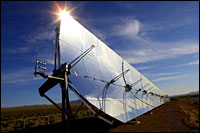
As part of the Back to the Future alternative energy series, The New York Times has an article today about the rising demand for solar thermal power plants, which use solar panels to heat water and operate a steam turbine.
Among the advantages cited:
On sunny afternoons, those 10 plants would produce as much electricity as three nuclear reactors, but they can be built in as little as two years, compared with a decade or longer for a nuclear plant. Some of the new plants will feature systems that allow them to store heat and generate electricity for hours after sunset.
In addition, solar thermal can provide energy more reliably than wind can, and it provides the most energy during mid-day, when energy usage peaks.
This technology has been around since the ’80s, but according to the article, the low cost of natural gas made solar thermal plants too expensive. Now, rising energy prices and opposition to coal are making solar thermal power more appealing. There’s still a cost disparity between the cost-per-kilowatt-hour of coal power vs. solarthermal power: 7 cents/kwh versus 15 cents/kwh. (Although they clearly aren’t taking into account the planet-destroying costs of coal.)
The article also talks about potential effects on biodiversity if solar thermal plants become widespread — obviously, if miles and miles of land are taken up for piping-hot solar panels, that could potentially be a bummer for wildlife:
Already, building a plant in California requires hiring a licensed tortoise wrangler to capture and relocate endangered desert tortoises.
But those problems seem minor in comparison to problems with coal. You know, little things like dangerous working conditions, filthy carbon emissions, and the potential for giant, 30-year underground fires that swallow up whole towns.
Maybe that’s just me.



